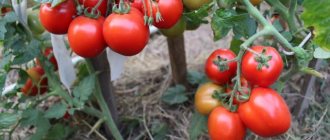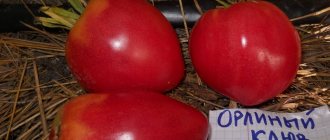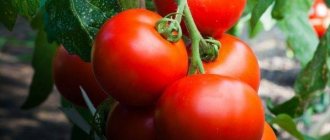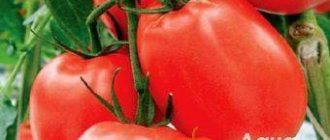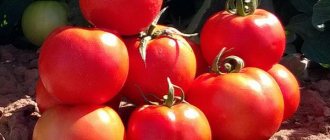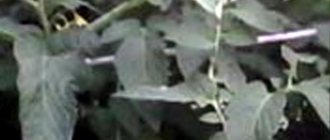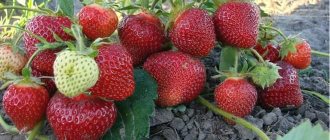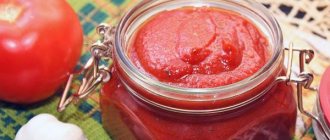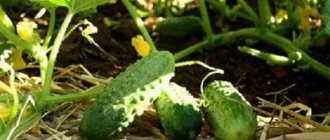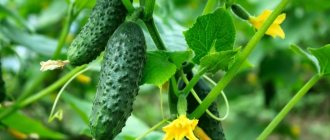Characteristics
The variety will delight you with its early ripening. After just 90 days, the first tomatoes begin to ripen. The bushes are standard, determinate type. In the ground they grow up to 50-60 cm. The height of the plant in a greenhouse may be slightly higher. The shape of the bush is compact, the foliage is medium. The leaves are dark green.
The description states that there is no need to plant the plant. Few shoots are formed and they do not affect the development of the bush, the rate of fruit formation and their ripening. In this regard, planting care is noticeably reduced.
Altai orange tomato
When planning to grow tomatoes, it is sometimes difficult to choose the right varieties - there are so many of them on the market today. Siberian breeders offer the Altai orange tomato, which has already proven itself to be a productive plant with an excellent fruit taste, to the attention of home garden owners.
Description of the variety and characteristics of the Altai orange tomato
The Altai Orange variety was bred in the Altai Territory by Barnaul breeders relatively recently - it was registered in the State Register in 2007. Originator - Demetra company, Siberia.
Tomato Altai Orange
The plant is a tall plant, reaching a height of 200 cm in greenhouse conditions. In open ground, the growth of the bush is limited to 160 - 170 cm.
The bush is heavily leafy and forms many stepsons. This feature should be taken into account when planting a plant in a greenhouse; bushes should be placed freely. If the bush is formed into one stem, the tomatoes will be larger. If you leave 1 - 2 powerful stepsons to form additional stems, the harvest will be larger, but the fruits will grow small.
Please note: this variety has varieties with fruits colored red and pink. Mid-season tomato, harvested 115 days after emergence
Tomatoes have a flat-round shape with slight ribbing. At the stage of technical ripeness (the fruits have reached the desired size and can be removed for further ripening), the tomatoes are yellow with a whitish spot at the stalk. When fully ripe, tomatoes turn bright orange.
The tomato is mid-season, harvested 115 days after emergence. Tomatoes have a flat-round shape with slight ribbing. At the stage of technical ripeness (the fruits have reached the desired size and can be removed for further ripening), the tomatoes are yellow with a whitish spot at the stalk. When fully ripe, tomatoes turn bright orange.
The weight of the fruit is 280 - 400g, individual specimens can weigh half a kilo or more. The total yield in film greenhouses is 8 - 10 kg per 1 sq. meters. In open ground, under favorable conditions and proper agricultural technology, 12 - 15 large ripe fruits can be harvested from one bush.
The Altai variety is distinguished not only by its large and fleshy tomatoes. It is noted by tomato lovers for the pronounced taste of the fruit and its sweetness.
Please note: Altai tomatoes are recommended for fresh consumption in salads and sauces. Tomato juice prepared from the fruits of this variety looks elegant, has a pleasant thickness and rich taste.
Tomato juice prepared from the fruits of this variety looks elegant, has a pleasant thickness and rich taste.
Important! Tomatoes with orange and yellow fruits can be consumed by people with allergies to red fruits. Tomatoes have a beneficial effect on the functioning of the heart and intestines
The variety is suitable for cultivation in open ground in the southern regions of the country. In the central zone, the Moscow region and Siberia, the crop is grown in greenhouses and greenhouses.
Features of cultivation
Altai orange is sown at a time suitable for all mid-season varieties. The plant is planted in open ground with the onset of stable heat, placing it according to a 50 by 70 cm pattern.
Tall tomatoes need strong stakes for support. Trellis are installed in the greenhouse for plants.
It is necessary to regularly remove stepsons and lower old leaves to improve ventilation of the bushes.
Attention! This variety is not resistant to late blight. Preventive treatment of bushes with garlic infusion and whey will help to avoid the disease.
Advantages and disadvantages
The main advantages of tomato include:
- excellent taste;
- their large size;
- meatiness.
Disadvantages of the variety: abundant formation of stepsons and instability to late blight.
This variety is not suitable for industrial cultivation, but in the caring hands of an amateur gardener, the plant will show its best qualities - it will give tasty and large fruits.
Fruit
By the end of June, low bushes are strewn with small, round or rounded-flattened fruits. The tomatoes are beautifully shaped, weigh no more than 100 g. In the phase of biological ripeness, they are painted bright red. The pulp is dense, red, juicy.
The fruiting period of tomatoes planted in the ground is long. They ripen evenly from July to August. Small tomatoes can be used for more than just salads. They are good at pickling and serve as a good raw material for making canned winter vegetables.
Advantages of the variety
The main advantage of this variety is its low dependence on weather conditions. Regardless of the weather, there will be tomatoes on the table. It is also important that this variety can be grown not only in the ground. The yield of Ural early in the greenhouse is even higher by several kilograms.
For dachas where there is little space left for a vegetable garden, the variety is simply irreplaceable. Due to the low growth and compactness of the bushes, you can plant tomatoes in a compacted pattern and still get a decent harvest.
Early ripening is also an important characteristic for a harsh region with short summers. It’s not bad when tomatoes ripen right on the bush. Their taste is much better and the pulp contains more beneficial properties.
The breeders did their best for the Ural summer residents. The bushes do not suffer from late blight. This is important for the overall health of the garden. The less fungal infection there is on the site, the better the quality of the vegetable harvest and the longer it will be stored.
Cherry
A variety with medium fruit ripening periods (90-100 days), can be grown in greenhouses and open ground. The height of the bushes does not exceed 1.8 meters, the fruits are small, round, weigh only 10-20 grams, and up to 25 pieces are formed on one cluster. Depending on the variety, the skin may be red, pink or black. This variety is often grown even on balconies due to its attractive appearance. You can harvest up to 4 kg of tomatoes from a bush.
Tomatoes of this variety are available in red, yellow and unusual almost black colors.
Growing tomatoes in the Urals
They are preparing for the planting season in the Urals in the fall. A fertile mixture is poured into garbage bags, which is used in the spring to grow seedlings. Compound:
- River sand, washed 1 part.
- Garden soil or soil from the garden, 2 parts.
- Mature compost (well-rotted humus) 2 parts.
See also
Characteristics and description of the Pink Elephant tomato variety and its yieldRead
Bags of prepared soil are stored in the cold. This partially disinfects it. Most of the larvae of garden pests die.
March
March is coming - the month when all the summer residents of the Urals take out bags of seeds. Bags of soil should be brought into a warm place earlier, already in early March, thawed, and watered with a solution of potassium permanganate. If late blight raged in the garden in the previous season, use a fungicide solution to disinfect the soil.
Sow the seeds in the ground on March 15-20. Sow in boxes, do not deepen them more than 1 cm. Cover the boxes with polyethylene and keep warm (25-28 °C) until shoots emerge. In the 2-leaf phase, plant the plants in separate cups and continue to grow at a lower temperature (18-20 °C).
Transplanting seedlings into the ground causes stress in young plants. The stress level is lower if you start hardening procedures a week before the event. If you have a greenhouse or polycarbonate greenhouse, it is easier to harden. Place the boxes with seedlings in the greenhouse. Open it during the day and cover it with covering material or straw mats at night.
Planting seedlings
Ural early is planted in the ground at the beginning of June, in a greenhouse - from late April to late May. Plantings can be done densely. Leave 30 cm between the holes. In general, stakes are not needed, but if the bushes begin to fall over due to the abundance of fruits, you can put a low peg and tie the stem to it in several places.
Water the bushes according to the weather in open ground and once every 5 days in a greenhouse. The bushes are compact and do not require large volumes of water. In the hottest weather, 0.5-1 bucket for 1 root is enough. Don’t forget to feed low tomato bushes with complex fertilizer 2-3 times a season. Choose those marked for tomatoes.
In August, the lower leaves can be gradually removed, this will make it easier for the bushes to further form fruits and prolong their fruiting. Timely harvesting of fruits that have reached milky ripeness also prolongs fruiting. Another advantage from timely harvesting is that the fruits are uniform in size.
See also
Description of the tomato variety It grows itself, its characteristics and yieldRead
Varieties for the Ural region
In the Urals and Siberia, the best varieties of tomatoes are early ripening ones. Those hybrids and varietal tomatoes whose ripening period is June-July have time to ripen . The early harvest is used to prepare salads and other vegetable and meat dishes. Therefore, salad varieties with good taste are of interest.
The following hybrids are zoned in the Ural region and show good results:
- Burzhuin F1.
- VIP F1.
- Erofeich F1.
- Cherry strawberry F1.
- Pink miracle F1.
Hybrid Burzhuin F1 produces a medium-sized fruit crop (180 g) in a short time (95-100 days). The shape of the fruit is flat-round with pronounced ribbing. The color of the skin and pulp when ripe is red. The taste is typically tomato, sweet and sour.
Bigwig F1 is another hybrid grown in the Urals. The bushes are low, determinate type. The fruits are red, not large (115 g), ripen early (90-100 days).
Erofeich F1 is a determinate plant, early ripening (90 days). The fruits are not large (100 g), red. The shape is flat-round with ribbing along the perimeter. The pulp has an excellent tomato taste.
Cherry strawberry F1 is a plant with bushes of medium height up to 140 cm. The fruits are shaped like garden strawberries. They are collected in brushes of 6-7 pieces. The shape is elongated, oval. The pulp is sugary, raspberry in color. Weight up to 110 g. They ripen already on the 95th day from planting. The plant has excellent immunity to mosaic and late blight.
The pink miracle F1 begins to ripen after 85 days. This hybrid is grown successfully both in the ground and in greenhouses (film, polycarbonate). Sweet fruits weighing up to 100 g are characterized by increased sugar content. The pink flesh is juicy and tasty. From a square meter of ridge you can collect up to 20 kg of fruit.
When planting any variety or hybrid, you need to take into account varietal characteristics. The planting scheme and care must comply with the instructions given on the package of seeds. Compliance with all conditions is a guarantee of the harvest declared by the manufacturer for each specific variety.
Diseases and pests
Varieties with large and sweet fruits tend to attract various types of pests. For greenhouse tomatoes, the main threat is late blight. To minimize the risk of infection, it is necessary to observe correct crop rotation and take preventive measures in a timely manner.
Adviсe
- You cannot plant tomatoes next to potatoes, and also after peppers and eggplants;
- The soil must be loosened frequently and the beds must be weeded;
- The greenhouse must be ventilated regularly;
- The plantings should not be thickened; excess leaves should be removed from the bushes;
- Do not fertilize the soil with fresh manure;
- It is recommended to disinfect the greenhouse with lime chloride;
- Plants need to be treated with Bordeaux mixture or copper oxychloride, watered with an infusion of ash;
- If there are obvious signs of late blight, you can treat the bushes with oxychome, “Profit” or “Kartotsid” preparations.
The popular Ural Giant tomato is a whole series of four varieties. They are united by similar bush dimensions, impressive fruit sizes, and sugary pulp. They vary in color - red, pink, lemon (yellow), orange. They successfully adapt to the weather conditions of different regions.
